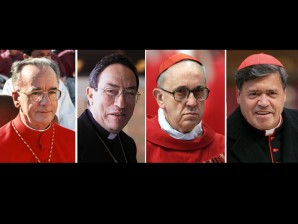
A combo of recent file pictures of candidates from Latin America to succeed Pope Benedict XVI (L to R) Brazilian Cardinal Claudio Hummes, Honduran Cardinal Oscar Andres Rodrigues Maradiaga, Argentine Archbishop Jorge Mario Bergoglio and Mexican Cardinal Norberto Rivera Carrera. The Vatican on February 11, 2013 said it expected a new pope would be elected next month, after Pope Benedict XVI said he would resign on February 28. AFP PHOTO/STF
MEXICO CITY—Latin America is home to the world’s largest Roman Catholic population, but hopes that the next pope will come from the region appear faint, experts said Monday.
The predominance of Europeans on the College of Cardinals means that the odds are stacked against a Latin American pope, even though the names of a number of high-ranking churchmen from the region have been bandied about, analysts said. The 118-member college, with 62 European members and only 19 from Latin America, will elect a successor for Pope Benedict VXI, who announced Monday he will resign due to age.
Still, hope springs eternal.
“Since Latin America is a fortress for Christianity during these rough times, it would be healthy for us to get a Latin American pope,” said Fernando Reyes, 57, a professional violinist, who prays daily at the La Merced church in Santiago, Chile.
Crossing himself before leaving the church, Reyes noted, “I would be proud. We’ve had Italian, Polish, German. It’s time for a Latin American.”
Brazilian Cardinals Joao Braz de Aviz and Odilo Pedro Scherer, and Argentines Leonardo Sandri and Jorge Mario Bergoglio have been mentioned as possible contenders.
Also mentioned in 2005, when Benedict was chosen, was Honduran Archbishop Oscar Andres Rodriguez Maradiaga.
But it is unclear whether any one of them could gain traction.
“To see the possibilities for a Latin American pope, you have to look at the makeup of the College of Cardinals,” said Bernardo Barranco, an expert at Mexico’s Center for Religious Studies. “From the get-go, I see it as difficult for a Latin American . . . because the college has not only been “re-Europeanized,” it has also been “re-Italianized.”
While some see Latin America’s estimated 40 percent of the world’s 1.2-billion Catholic population as a bulwark of the faith, the church is also facing challenges in the region from evangelical churches.
In Mexico, the percentage of the population who identify themselves as Catholics dropped from over 90 percent in the 1980s to 84 percent in 2010, the latest year for which data is available.
In Brazil, home to a number of charismatic or evangelical churches, the drop has been even more precipitous, from 84 percent in 1995 to 68 percent in 2010.
“In numerical terms, Latin America is majority Catholic, in broad terms, but these aren’t the best times for the church,” said Barranco. “On the contrary, it is going through a severe crisis the like of which it has never seen before.”
Still, some see Latin America’s still-large Catholic population as a decisive force.
“It would be a central argument for electing a Latin American pope, because the future of the church is in the Southern Hemisphere,” said R. Andrew Chesnut, a professor of Religious Studies at the Virginia Commonwealth University. “I am not going to make any predictions, but I think there will be a contingent of European cardinals who would support an African or Latin American candidate.”
For Rosita Mejia, 44, who has sold religious items for 25 years outside the La Merced church, the next pope’s country of origin is less important than his vigor, energy and proximity to the people, none of which were distinguishing characteristics of Benedict VXI.
“In five years, only one person has asked me for a Benedict prayer card. In comparison hundreds of people have asked for John Paul II,” Benedict’s more charismatic predecessor, she said. “I would like for the next pope to be younger, and have more time to travel the world, and perhaps come to Chile like John Paul did.”